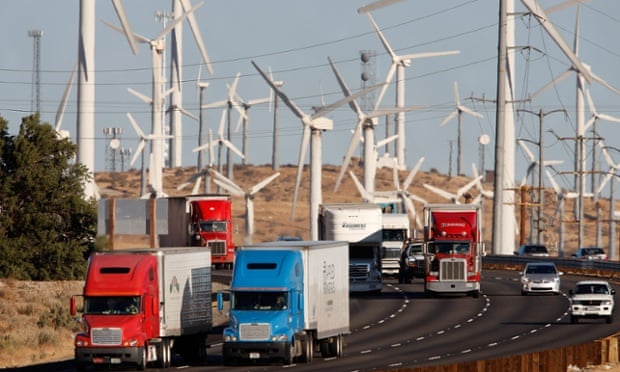More electricity from renewables, fewer gasoline-powered
vehicles and lower power consumption by buildings mandated under ‘50-50-50’
agenda.
Californian lawmakers want 50% of electricity from
renewables and 50% less petroleum used on the roads by 2030.
California lawmakers
have passed a dozen ambitious environmental and energy bills setting high goals
for reducing greenhouse gas emissions and petroleum use, and creating new
standards for energy efficiency.
Dubbed the California climate leadership package, the 12 bills
represent a Democratic-driven push in the Senate to advance an agenda of
technological innovation and conservation that was put into play by an
executive order by California Governor Jerry Brown in April. The package will
next move to the assembly for debate.
One of the cornerstones of the program is SB 350, which
calls for a “50-50-50” reduction in major areas of climate concern. It mandates
a 50% reduction in petroleum use by vehicles by 2030, the equivalent of
removing 36m cars and trucks from the road.
It also calls for 50% of the state’s electricity supply to
be derived from renewable resources by that date, and 50% better energy
efficiency in buildings through retrofits and upgrades.
“California has demonstrated our global climate leadership
over the last decade,” said Senate president Kevin de Leon after the passage of
SB 350. “These policies will further cement our leadership, further strengthen
our economy and protect the health of our communities.”
Another cornerstone of the legislative package is SB 32,
which continues executive orders first made by then-governor Arnold
Schwarzenegger in 2005 and later passed by the legislature in California’s
groundbreaking 2006 climate change law, which created cap-and-trade emissions
requirements for large industrial polluters like oil refineries and power
companies.
SB 32 increases those pollution reduction goals –
specifically from manmade greenhouse gases, requiring the state to reduce
emissions to 40% below its 1990 levels by 2030, and then increasing that to 80%
below 1990 levels by 2050.
The bill’s author, Senator Fran Pavley, pointed out that the
state was on track to meet the old goals set by the previous bill. Calling the
targets “science-based numbers”, she added that the creation of new
technologies was key to meeting those objectives. California has long prided
itself as a center of invention, and Pavely expressed confidence that the state
could find progressive ways to meet the increases. “I bet right now there is
some 20-year-old in some parent’s garage coming up with the next new
innovation,” she said.
SB 350 passed by a 24-14 vote and SB 185 passed by a 22-14
vote along party lines.
Other bills in the package included measures to push public
pension plans to divest in coal companies, require cities to include climate
considerations in their general plans, and a proposal to study atmospheric
rivers to increase water supply reliability.
Critics of the legislation, especially SB 350, said the
measures would lead to further economic hardship and job loss. The senate
Republican caucus opposed many of the bills, calling them unfair to inland
parts of the state that rely on traditional industries such as agriculture and
trucking, while favoring coastal areas that have more technology-driven
economies.
As California has rebounded from the recession, those rural
inland areas have seen less job growth and higher unemployment than larger
metropolitan areas with more diverse economies. Many voiced concern that the
bills would push companies – and work – into other states while overall doing
little to impact climate change.
“What I see in our emerging economy is coastal-elite winners
and the inland rural losers,” said Senate minority leader Bob Huff before
voting against SB 350. “The fact is we are using fossil-based fuels to feed the
world … when we stop burning fuel, coal for fuel, that doesn’t stop Arizona or
Oregon or other states from doing it, or China. And so we have a very lofty and
noble goal, but other than feeling good about it, what does it actually
accomplish?”
De Leon, who represents a district centered in Los Angeles,
later called the threat of job losses “scare tactics” and countered. “We can’t
be negative Nellies and Debbie downers and doomsday preachers that there is
going to be economic peril.”
He added that creating jobs was a focus of the legislation,
and citied previous actions such as Proposition 39, passed in 2012, which
provided funds for green retrofits in schools, and created jobs performing that
work.
“You can’t argue with a job that has been created,” he said.
“We can put people to work. But everyone has to be on the same page … It has to
be done with a sense of intentionality, with a sense of purpose. That’s what
we’re about.”


No comments:
Post a Comment